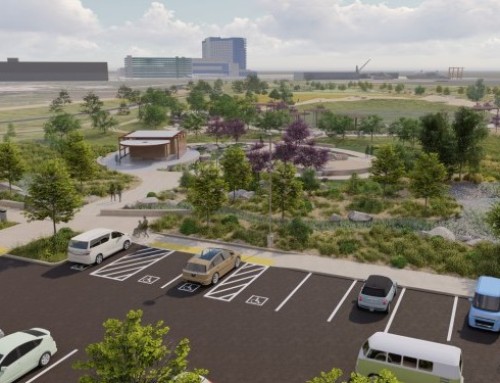Published in HONOR ROLL, LANDSCAPE ARCHITECTURE MAGAZINE; March 9, 2023
By Timothy A. Schuler
When Joseph Yamada and his wife, Elizabeth, died within nine days of each other in May 2020, obituaries and appreciations appeared in the Los Angeles Times, the San Diego Union-Tribune, and NPR. Most focused on the couple’s incredible story: Born two days apart in 1930, the two met at age 11 at a Japanese internment camp.
They later attended the same high school, studied together at the University of California, Berkeley, then moved back to San Diego, where Joe Yamada became one of the most celebrated landscape architects of his generation and Liz Yamada was the first Asian faculty member at San Diego High School, later joining her husband’s firm, Wimmer Yamada & Associates, as a partner.
The Yamadas’ deaths touched many in San Diego’s design community. “It was right at the beginning of the pandemic, and Liz did pass away from COVID, so for me, it hit hard,” recalls Kelsey Kaline, a historic preservation specialist at IS Architecture in San Diego. When the Yamada family organized an estate sale at the couple’s house in La Jolla, it attracted not just friends and neighbors but design enthusiasts who knew Joe Yamada by reputation. “I think a lot of people went just to pay respects to him,” Kaline says.
Also put up for sale was the Yamadas’ home, at 1676 El Camino Del Teatro, a 3,330-square-foot, 1970s modernist wood house designed for the couple by Liz’s brother, the architect David Kikuchi. With six decks extending the living space to the outdoors—described in a 1978 issue of the Los Angeles Times’s HOME magazine as akin to “beaches surrounding some wooded island”—the house is set back on the steeply sloped lot, with a Joe Yamada–designed, Japanese-style entry sequence that features a dry-laid stone path gently winding through dense plantings of Pinus thunbergii, Metrosideros excelsa, and Rhaphiolepis umbellata f. ovata.
In 2021, the house was sold to Troy Wu and Insun Lee, who recognized its historic significance and began exploring how to get it listed as a historic property at the local level. They contacted Kaline’s firm, which specializes in historic preservation. “They contacted us not only to get started with the designation process but to have a better understanding of what they could or couldn’t—or shouldn’t—change,” Kaline says. As far as she could tell, Wu and Lee genuinely wanted to “understand their role in conserving the property in the future. They want to be stewards of the resource, which is rare.”
…
In September 2022, the nomination for the Yamada House, located in a part of La Jolla known as the Muirlands, went before San Diego’s Historical Resources Board (HRB), submitted under Criteria B and C. The board agreed that the house should be designated. There was just one problem. “I find it ironic that we are designating the home of a landscape architect, and there are no landscape components in the designation,” Ann Woods, a professor of art history at San Diego State University and a member of the HRB, said at the meeting. What few landscape elements were mentioned were not identified as contributing to the historic nature of the property, something that struck Woods as odd. “I walked through that front yard, and clearly, it’s part of the design of the home. It was important,” Woods says now. The HRB tabled a vote and asked IS Architecture to inventory historically significant landscape features and to reapply for designation at a later date.
The omission of Yamada’s landscape from the original nomination is a reminder of how heavily historic preservation regulations are weighted toward architecture and also represent an opportunity for the field. “I don’t think we’re very well educated about landscape architecture, in general. You’ve got this civilian board, and we come from very diverse backgrounds,” Woods says (though the HRB is required to have a landscape architect on it).






